
|

|
Battle of Plymouth
Plymouth and the Civil War
The Fight For Plymouth
Plymouth, In Their Own Words

|
| Davis promotes Hoke |
During April 18-20, 1864, Brig. Gen. Robert F. Hoke, who succeeded to the
command of all the forces in this department, directed the campaign, and was also authorized by the Navy Department to secure
the co-operation of the Confederate ram, Albemarle, then near Hamilton on the Roanoke River, in an unfinished state and in
charge of Commander Cooke. Colonel Mercer, of the Twenty-first Georgia, commanded Hoke's Brigade. He was killed in a charge
at night upon a fort about half a mile in advance of the enemy's line of works at Plymouth, and Lewis, of the Forty-third,
assumed command and was subsequently promoted to Brigadier-General. The fort was taken and the Albemarle simultaneously steamed
down the river and engaged the enemy, sinking one of their gunboats and driving their flotilla a considerable distance below
Plymouth, thus relieving the land forces in future movements of the apprehended attack from them. During the night the different
commands were placed in position for the general assault upon the works around the town, and this necessitated the moving
of the troops by circuitous routes to avoid being discovered by the enemy, and consumed all of the 19th. Accordingly, on the
morning of the 20th Brig. Gen. Matt Ransom attacked on the east side of the town, Lewis on the west and Hoke, with the other
brigades, moved upon the enemy's center. The town was taken in a short while, the garrison and an immense amount of supplies
being captured. Forty-third North Carolina Regiment, Histories of the Several Regiments and Battalions from North Carolina
in the Great War 1861-'65, Volume 3.
We took part in the storming of the outer works and final capture of Plymouth,
April 20th. It was in this battle and whilst storming Fort Wessells that we first had to contend with hand-grenades. Whilst
our men were in the ditch around the fort the enemy threw hand-grenades quite freely, but they did not prove to be very destructive,
and the fort soon surrendered. This was about dark on the first day, and the surrender of this fort brought us in front of
the main line of works around the town. Early in the morning the battle was renewed all along the line, and the Ram "Albemarle"
was brought down the river to assist. The battle soon resulted in the capture of the town, with a large number of prisoners
and considerable stores. 6th North Carolina Infantry Regiment, Histories of the Several Regiments and Battalions
from North Carolina in the Great War 1861-'65, Volume 1.
Summary
The Forty-third North Carolina and Twenty-first Georgia Regiments were temporarily
attached to our brigades. Colonel Mercer, of the Twenty-first Georgia, being senior officer, took command of our brigade (General
Hoke commanding the whole army). In the first charge on one of the advanced forts, which was very strong, Colonel Mercer was
killed, and his men seeing no chance of getting in under this galling fire, began to waver, When Lieutenant-Colonel W. G.
Lewis, of the Forty-third, promptly taking in the critical situation, assumed command, and began to rally the men behind a
bluff in a few yards of the fort. He at once sent for two pieces of artillery, which soon battered down one corner of the
fort, and we went in without the loss of a man. This movement evidently saved the life of many a brave man. From this time
Colonel Lewis was in command of our brigade and was soon made Brigadier-General for his heroic conduct on this occasion.
We then moved on the town, and after a feeble demonstration by the enemy
it was surrendered 20 April, 1864, with 2,500 prisoners, 100,000 pounds of bacon, 1,000 barrels of flour and a vast amount
of other stores. Among these prisoners 22 had formerly belonged to our army, and had gone over to the enemy and taken up arms
against us. These prisoners were sent to Kinston, given a fair trial by court-martial, convicted of high treason, and duly
executed by our brigade. After this we went to Washington, N.C. The enemy soon fled destroying a vast amount of stores. At
this place we remained several days in perfect quietude. We then moved back to New Bern, where General Hoke expected to add
another gem to the diadem of his military fame, but alas! General Lee could no longer do without him and we were hurried to
Virginia. Fifty-Fourth North Carolina Regiment, Histories of the Several Regiments and Battalions from North Carolina
in the Great War 1861-'65, Volume 3.
| Plymouth Civil War History |
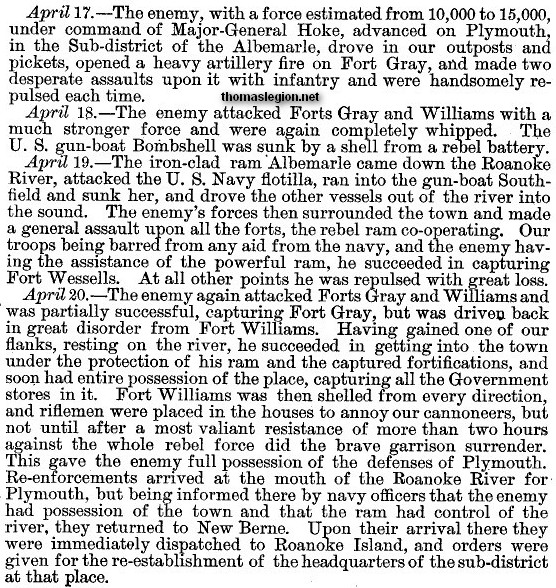
|
| Union Return for District of North Carolina for April 1864. |
| Plymouth Civil War History |
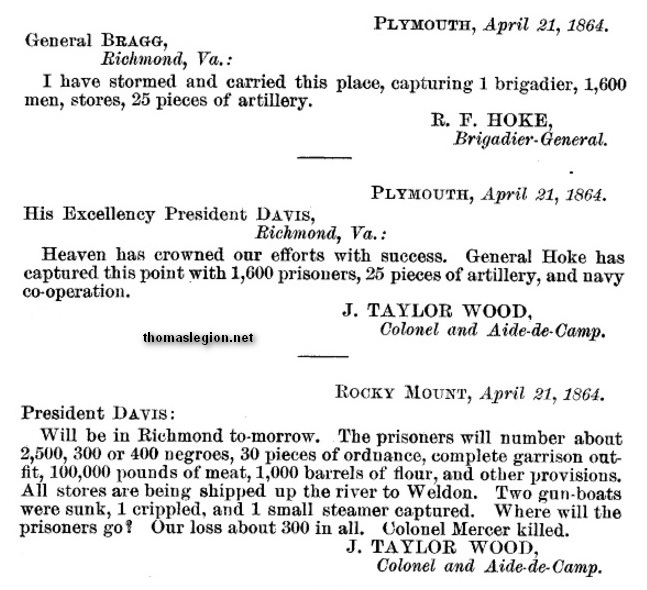
|
| Confederate Reports for Battle of Plymouth |
The Plymouth Campaign
14 April. The Twenty-fourth, Twenty-fifth and Fifty-sixth North Carolina
State Troops, under General M. W. Ransom, set out by rail and reported to Brigadier-General R. F. Hoke at Tarboro. The Forty-ninth
was on outpost duty near Edenton, and its place was now supplied by the Eighth, from Clingman's Brigade. 15 April. The column, consisting of Hoke's North Carolina Brigade under Colonel Mercer, of
the Twenty-first Georgia Regiment, which was then with it; Kemper's Virginia, under Colonel Terry, and Ransom's North Carolina
Brigade with Pegram's Battery, under General Ransom, and Stribblings', Graham's Virginia, Miller's, Moseley's and Reade's
batteries of artillery belonging to Colonel Dearing's command, and Dearing's Battalion of cavalry, took up the line of march
against Plymouth. At Hamilton we were joined by the Thirty-fifth North Carolina. Passing through Williamston and Jamesville,
we reached the vicinity Sunday, the 17th, a little before nightfall. Immediately
a strong line of skirmishers, including Company I, of the Fifty-sixth, was thrown out from Ransom's Brigade, under Major Graham,
and pushed forward nearly to the entrenchments. A picket post of eleven men was surprised, nine captured, one killed and one
escaped. A reconnoissance in force was made in front of Fort Gray, on Warren's Neck, between the mouths of two creeks emptying
into the Roanoke, two miles west of Plymouth, and Dearing's artillery crippled one of the boats so that it sank on reaching
the wharf. A redoubt was immediately begun on the Jamesville road leading south for our 32-pound Parrott gun. The iron-clad
Albemarle, Captain J. W. Cooke, was expected during the night. Fort Gray's armament was one 100-pounder and two 32-pounders.
18 April. The Albemarle, for some reason, was making slow progress down
the Roanoke, and the day passed without a sign of it. Shelling at intervals was kept up, the Fifty-sixth suffering but one
casualty, the wounding of a man in Company H. During the night Colonel Faison, with 250 men, had completed the earthwork near
the Washington and Jamesville road from which to bombard the fort at Sanderson's. At sundown a demonstration on both sides
of Lee's Mill, Bath road, was made against the enemy's south front by the artillery and Ransom's Brigade. Our assaulting column
was formed with the left resting on Frank Fagan's house on the Jamesville road, a mile and a quarter south of town, and two
regiments, the Twenty-fourth and Eighth, beyond the Lee Mill road at Redd Gap. The Fifty-sixth was next on the left, and then
the Thirty-fifth, while the Twenty-fifth connected us with Hoke's right. The batteries following on the heels of a battalion
of sharpshooters composed of Companies B, I, E and A, of the Fifty-sixth, under their worthy Captains, Roberts, Harrill, Lockhart
and Hughes, led by Captain Jno. C. Pegram, Assistant Adjutant-General, driving the enemy over their breastworks, advanced
steadily from position to position, firing with the utmost rapidity, while the rest of the brigade in the line of battle kept
pace with them. Ransom was conspicuous on the field, keeping his mount throughout the engagement. This was kept up till 10
p.m., the enemy replying with great spirit from his forts and gunboats, carrying twenty pieces. The object was as far as possible
to draw the enemy's fire in this direction, while Hoke's Brigade assaulted in earnest the "85th Redoubt" at the Sanderson
house, some distance to our left. The fort was carried after a very stubborn resistance and the death of its commander, Captain
Chapin. Among our killed we mourn the loss of the brigade commander, the gallant Colonel Mercer, of the Twenty-first Georgia.
Lieutenant Charles R. Wilson, of Company D, and 14 men of the Fifty-sixth North Carolina were wounded at our end. Colonel
Mercer was a West Point classmate of Generals J. E. B. Stuart, Hood, Custis Lee, and W. D. Pender. He is buried at Tarboro
beside his last named comrade.
19 April. Towards day Colonel Wm. J, Clarke, with his own, the Twenty-fourth, and the Fifty-sixth Regiment, was posted
below the town on the Columbia road, to prevent escape in that direction. But the enemy was still confident in the strength
of his fortifications, even after the loss of the "85th Redoubt" and the arrival of our ram, Albemarle, the same night passing
the big gims at Warren's Neck unharmed. It sank one of their gunboats, the Southfield, and chased off the other two, the naval
commander, Flusser, being killed on the deck of the Miami. The enemy still held a continuous, thoroughly fortified line, well
constructed, from a point on the river, near Warren's Neck, along their west and south fronts, and terminating on the east
in a swamp, bordering which a deep creek, known as Conaby, a mile or two further east, runs into the Roanoke river, on the
south bank of which Plymouth is situated. It has four streets parallel with the river and five at right angles to it. Fort
Williams, projecting beyond the south face of the parallelogram, is ready for action on all four sides and enfilades, right
and left, the whole south front of the fortifications, while Battery Worth was built to command the west, water and land,
approach. Between the latter and Warren's Neck was 85th Redoubt at Sanderson's house. At Boyle's steam mill near the road
entering Second street from the west was another redoubt outside the entrenchments, and within the southwest angle still another
at Harriet Toodles'. On the east centre was Fort Comfort, with a redoubt on either side of the Columbia road at James Bateman's
and Charles Latham's. General Hoke ordered an assault from this (east) side by Ransom's Brigade. Accordingly that night our
sharpshooters effected a crossing of Conaby creek on felled trees with some opposition. A pontoon bridge was laid, and before
the night was far advanced, the brigade was over. With a line of skirimishers out in front, the brigade slept in line
of battle, and perhaps never more soundly, for tired nature's sweet restorer was welcome, even on the eve of certain battle.
| Plymouth and the Civil War |
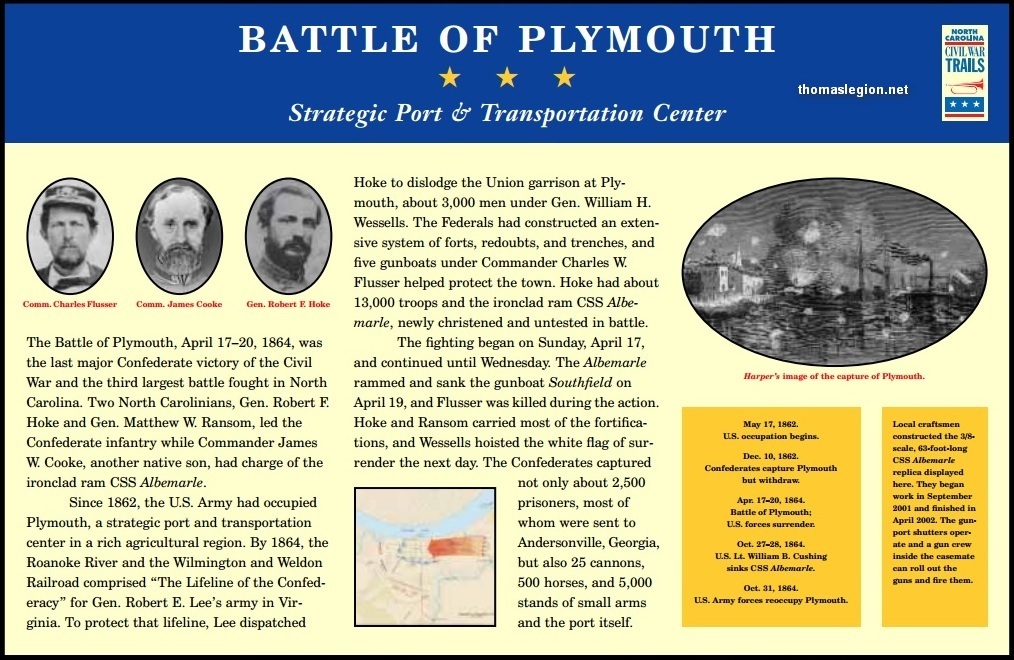
|
| Battle of Plymouth |
| Fayetteville Observer, May 9, 1864 |
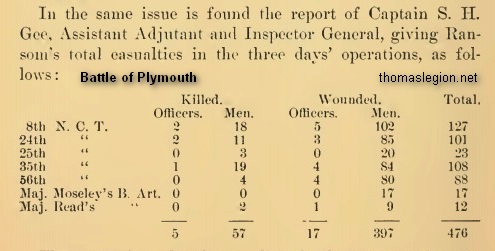
|
| Plymouth after battle report |
20 April. At the first break of day Ransom was again in the saddle, and
his ringing voice came down the line: "Attention, brigade!" Every man was upon his feet instantly, and the adjusting of twisted
blankets across the left shoulder and under the belt at the right hip was only the work of another moment; the line of battle
was formed, "Fix bayonets," "Trail arms!" "Forward march!" and the charge began. The alignment was as follows: The Fifty-sixth
on the right, flanked by Company I, as sharpshooters, (resting on the Roanoke and near the "Albemarle," then engaged, as it
had been at intervals through the night, with Battery Worth on the river face of the town), and Twenty-fifth, Thirty-fifth,
Eighth and Twenty-fourth successively on to the left. On our part of the line a large drove of cattle was encountered and
driven on as a living wall between us and the enemy until they reached the canal, down which they refused to plunge, or escort
us further. Maddened by this strange spectacle of "man's inhumanity to man," they turned about, and "with no reputation to
lose," dashing through our line, sought safety in flight. The canal was found with steep banks, but fortunately with fordable
water. Ranks were necessarily broken in getting across, but were soon in perfect order on the farther side, and the forward
movement resumed. The next obstacle was a swamp, in places waist deep, through which the regiment floundered as best it could,
impeded by the mire and cypress knees with which it abounded. The Fifty-sixth was the first through, and immediately reforming
under an oblique fire from the left, charged up a slight hill, and routed the opposing regiment sheltered behind a fence of
palings, here the outer line of the town. This and the adjacent houses blocked further advance in regimental line of battle.
But the halt here was only for a moment. Company I pressed straight forward, sweeping everything before them between Water
street and the river bank, while the Twenty-fifth on getting through the swamp and finding the Fifty-sixth in its front, debouched to the right and thus went up Water street between the Fifty-sixth
and its detached company. At the same instant General Ransom, reaching this point, the Fifty-sixth moved off by the left flank
and entered the town on the next street east, by filing to the right, left in front. Major Graham was at the extreme left,
now head of column, and on gaining the open space about the county jail, deployed the regiment forward into line of battle,
just in time to checkmate a battery of artillery taking position to rake the street with its guns. These movements and the
obstacles encountered, again divided the regiment, carrying the Colonel and Lieutenant-Colonel back to Water street to direct
the extreme right, while the Major, with eight companies, pressed forward to silence the artillery. The fire, delivered before
we could reach them, was fortunately a little too high, the shells in a direct line being plainly visible as they passed over,
and the guns were at once in our possession—not, however, until one brave fellow had blown up his limber in our
faces, killing his nearest horses and wounding several of our men. It
would be a pleasure here to record his name. The man retreating with the caisson was killed in the street, with four of his
six horses, by a shell from Fort Williams.
This wing of the regiment, then, without waiting for any support,
as all seemed to have enough to do, swept on fighting between these two streets the entire length of the town, and without
a halt charged the redoubt in their front, oonstituting a west section of the enemy's heavy line of fortifications, facing
front and rear. Here they captured a Pennsylvania regiment, and Major Graham, mounting the works with the regimental flag,
waved it to Hoke's Brigade, now under Lieutenant-Colonel Lewis (afterwards Brigadier-General), and thus announced that the
way was open on that side. In this last charge the Twenty-fourth went in abreast with us, having entered the town by the Columbia
road, which leads into Second street, after crossing Conaby creek with a northwest trend and then midway changing to due west.
While the Eighth and Thirty-fifth swung around to invest Fort Comfort, the Twenty-fourth overcoming all opposition before
them at the Bateman and Latham redoubts, pushed forward and connected with our
left flank as we struck the fortifications, —redoubt and entrenched camp. Major Graham's prisoners, some 300 of infantry
and artillery, were turned over to Captain Joseph G. Lockhart, when, under shelter of a ravine, uniting his battalion with
Hoke's Brigade, he swept down first the west and then the south intrenchments to Fort Williams, into which General Wessells
had withdrawn with the remnant of his army. The Twenty-fourth came up on the other side. After consultation with Colonel Lewis,
it was deemed unnecessary to assault it, as its surrender would be compelled by our artillery with the aid of sharpshooters
being rapidly posted to overlook its interior from the windows and tops of the nearest houses. The two opposing generals then
met in a personal interview, and the demand to capitulate was refused. But the inevitable was soon acknowledged by raising
a white flag, as we had silenced every gun in the fort. Meantime, the part assigned to Harrill's men, under their fearless
leader, had been as effectually accomplished. Through water hip deep, they had
crossed the canal and swamp, and keeping near the river, passing around houses and bursting through garden and yard fences,
they reached the rear of Battery Worth, containing the 200-pounder, specially provided to anticipate the coming of our iron-clad
Albemarle.
One volley was sufficient. The white
flag was run up and the battery, with some twenty artillerymen, surrendered to him. Taking the prisoners with them from this
battery on the river, they immediately charged to their left and thus struck in the flank and rear the right section of the
enemy's line of battle occupying the breastworks, here on Water street, facing up the river. His demand to surrender
was promptly complied with, and while Harrill here gathered in his prisoners, largely outnumbering his own rank and file,
Lewis' men who had held the attention of the enemy in their front, came in at a double-quick over the causeway leading through
the swamp on the west of Plymouth passed Hairill's position and joined Graham's detachmout at the upper ravine further to
the south, as above noted. How does it happen, then, that the capture of Battery Worth,
or Fort Hal, noted above as by Company I, has been claimed for Company B, with whom were Colonel Faison and Colonel Bearing,
a portion of the Twenty-fifth supporting the artillery? Both claims are literally true. A correspondent to the Fayetteville
Observer, 22 April, 1864, says: "On the river face of the town was a camp entrenched to resist any attack from the water,
and a little lower down an earthwork for the same purpose." The latter, admitted to be Battery Worth, we must observe the
distinction between the two, though close together. As to the time of the first movement, Captain Harrill's report is embodied
in the foregoing narration. General Wessells report: "At daylight the following day, 20 April, while my right and front were
seriously threatened, the enemy advanced rapidly against my left, assaulting and carrying the line in that quarter, penetrating
the town along the river and capturing Battery Worth." This left the entrenched camp not yet captured, and as no other Confederate
troops were in that quarter at that early hour, the claim of Company I to Battery Worth is thus afiirmed. From this point
of time General Wessells thus continues: "A line of skirmishers was formed from the breastwvorks perpendicularly towards the
river in hopes of staying the advance. This effort succeeded for a time; but the troops seemed discouraged and fell back to
the entrenchments."
The conduct of the Fifty-sixth was well calculated to create such discouragement,
as it broke through all obstacles, driving the enemy from the streets, yards, houses, cellars, and bombproofs from which Major
Graham says they came out like a colony of prairie puppies, or ground hogs on the 2d of February. As those not captured in
this charge were thus gradually pressed back to their double-faced entrenchments, the infantry garrison in the entrenched
camp at Battery Worth, guarding the water approach and, owing to the contour of the ground, not in sight from his side of
the fortifications when Capt. Harrill some two hours before had taken the artillerymen out of the battery, appear now to have
had their attention diverted from the commotion of the Albemarle down stream to their right and Hoke up the river to their
left. They now for the first time saw their enemy in the town, and were
ready with the portion of the retreating line that had joined them, to enfilade Company B as it came up. Here Colonel Faison,
with this gallant company under Captain F. N. Roberts, had his hands full for some time and accomplished important results,
as described by the subsequent Captain, then First Sergeant A. R. Carver: "In this charge our Lieutenant, B. W. Thornton,
fell on Water street with a bullet through the side of his forehead near the eye. I stopped long enough to see the wound,
and thought him dead; but he survived for a day or two. Our company had become detached by the evolutions and obstacles in
getting through the town. Just before General Wessells capitulated, say by 9 or 10 o'clock, we had reached the vicinity of
Fort Hal, with the 200-pound gun bearing on the river. It was full of the enemy, on whom we were firing with our rifles and
they were briskly returning our fire. Colonel Faison came up to me during this firing, when I pointed to a hill on the right
overlooking the fort, and said if the artillery were posted there, we would have the fort in five minutes. Soon after he left me, I saw our battery open from the hill, and immediately a white handkerchief
was hoisted on a bayonet above the fort. I was very near and ran for the fort. General Dearing got across the moat and into
the fort ahead of me, and jumped on tbe big gun as if he were going to spike it, which I met an officer at the gate and demanded
his surrender. He asked to be allowed to surrender to some higher officer. I called General Dearing and he told him to surrender
to me. He thereupon handed over his sword and pistol, which I kept during the war. I think he belonged to the infantry. He
had on his overcoat."
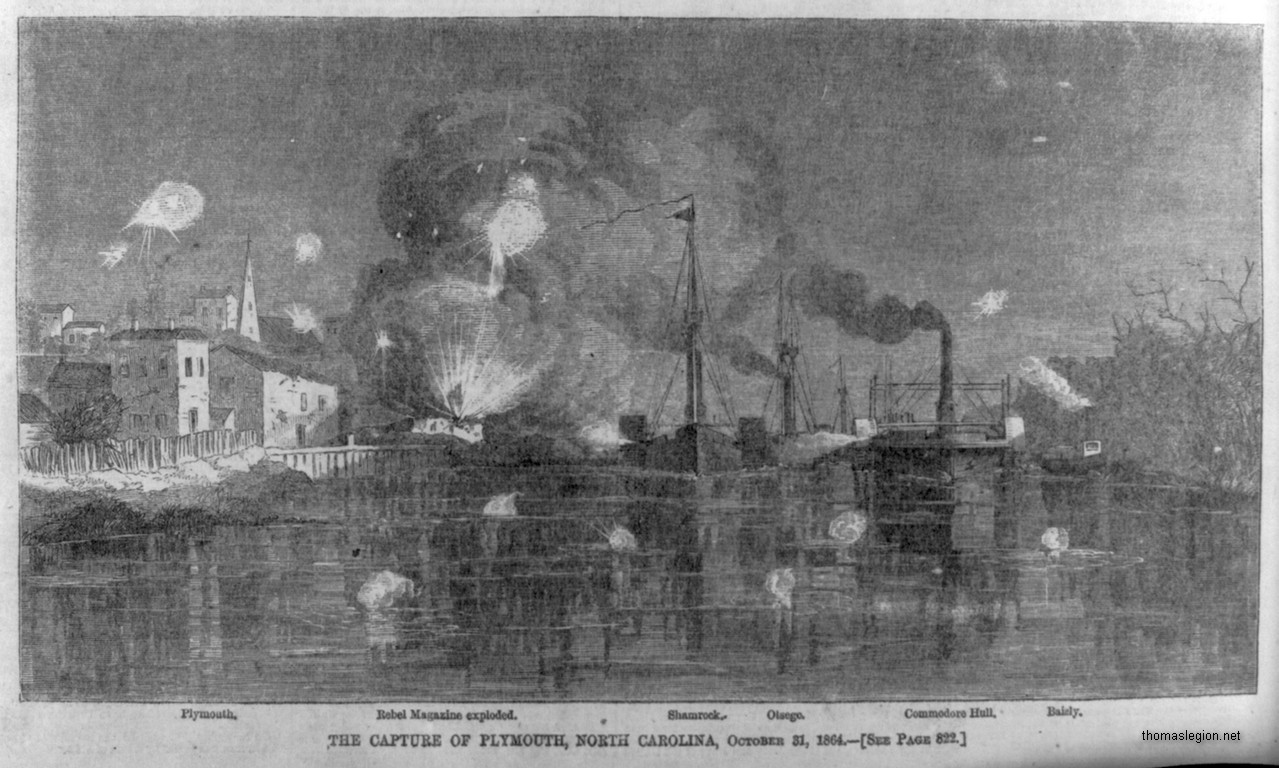
(About) The Capture of Plymouth, North Carolina, October 31, 1864. Illustration,
Harper's Weekly, (December 24, 1864), p. 820. Northern papers celebrate Union forces retaking Plymouth some six months after its
humiliating loss to Hoke.
| Battle of Plymouth |
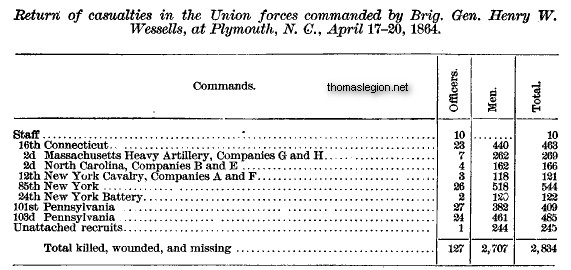
|
| Official report of Union casualties at Plymouth |
(Right) Casualty report filed by Wessells following his captivity in a Confederate
prison.
So there were two captures of the same fort, separated by an interval of
two or three hours. General Dearing (Colonel at Plymouth), subsequently fell 6 April, 1865, at High Bridge, on the retreat
towards Appomattox Court House, in a hand-to-hand contest with Major Read, of General Ord's staff, both antagonists going
down together. The big gun was naturally the chief attraction to him, and of course he believed to the day of his death that
his portion of the line had captured it, whereas it clearly appears that it had been silent for at least two hours, ever since
Captain Harrill carried off the artillerymen who had served it. It was the infantry of the adjoining entrenched camp, together
with some others, who had taken refuge in the vacant fort, that he and Colonel Faison so effectually silenced; and we may
say in the spirit of the generous Schley, "there was glory enough for all." The possibilities of such independent actions
by detachments may be better understood when it is remarked that within the fortifications on the west side were three ravines,
and on an elevation between the lower one and the river was planted Battery Worth, with the entrenched camp lower down. The
redoubt at Boyle's steam mill on the road on this side of the town, appears to have been blown up by a shell entering its
magazine, and so it offered no resistance to our infantry, wlile that at Harriet Toodle's, about the southwest angle, and
the intervening entrenched camps were taken with the connecting breastworks. The writer was near General Hoke when he received
General Wessells, accompanied by his officers, as his prisoner. There was everything in his courteous and considerate bearing
to lessen the sting of defeat. Dismounting from his horse and clasping the captive's hand, he assured him of his respect and
sympathy, and added: "After such a gallant defense you can bear the fortune of war without self-reproach." General Wessells'
official report, made after his exchange four months later, says that Hoke's conduct was courteous and soldier-like. His return
of casualties, killed, wounded and missing was 127 officers and 2,707 men, from the Sixteenth Connecticut Infantry, Second
Massachusetts Heavy Artillery, Second North Carolina (Union) Infantry, Twelfth New York Cavalry, Eigthy-fifth New York Infantry,
Twenty-fourth New York Battery, and One Hundred and First, and One Hundred and Third Pennsylvania Infantry.
Besides 3,000 stand of small arms and some twenty pieces of artillery, there
was a large quantity of all other supplies. In our advance there were no shirks. The respective muster rolls might be exhibited
as lists of those deserving honorable mention. The splendid conduct of Color Guard Corporal Job. C. Hughes, of Camden county,
is here gratefully remembered. The regimental colors were carried by a Sergeant, later on given the rank of Ensign by the
Confederate Congress, and he was supported by eight volunteer Corporals. This guard of three ranks in line of battle formed
the extreme left of the right centre company. This position fell to Company D, and was retained by it to the end of the war.
It was thus in the assault upon the redoubt beyond the head of Second street that the Captain of this company found Hughes
at his side while a blue coat in front was drawing a bead on him within a space less than the width of the street—"Hughes,
kill that Yank," followed, and the enemy's aim was as deliberately changed to save his own life. There was one report from
two rifles, and both men went down. It was the last shot ever fired by the Federal. His sight was as good as that of his focman,
his minie ball perforating Hughes' blanket thirteen times, as it was twisted and worn as above described, but ended with the
penetration of the breast-bone—probably owing to his not having driven the ball home in too rapidly loading his piece.
Within about a month he was at his post again. He was a brother of the gallant Captain of Company A. In this charge the brave
Corporal Wm. Daves, volunteer to the Color Guard from Company I, was killed, and J. P. Sossaman, of Company K, was also severely
wounded at the flag.
The "Albemarle" had advanced along the river front with the charge,
firing over the line. The honor of capturing Fort Comfort on our left, fell to the Thirty-fifth North Carolina and it was
renamed Fort Jones in honor of its Colonel. General Hoke was thereupon promoted to Major-General in recognition of this successful
initiation of his campaign, and of a well earned record for gallantry and efficiency in the Army of Northern Virginia, and
Colonel Bearing was made a Brigadier-General. Lieutenant-Colonel Lewis was soon thereafter promoted to Brigadier-General.
Fifty-sixth North Carolina Regiment, Histories of the Several Regiments and Battalions from North Carolina in the Great
War 1861-'65, Volume Three.
| Plymouth Battlefield |
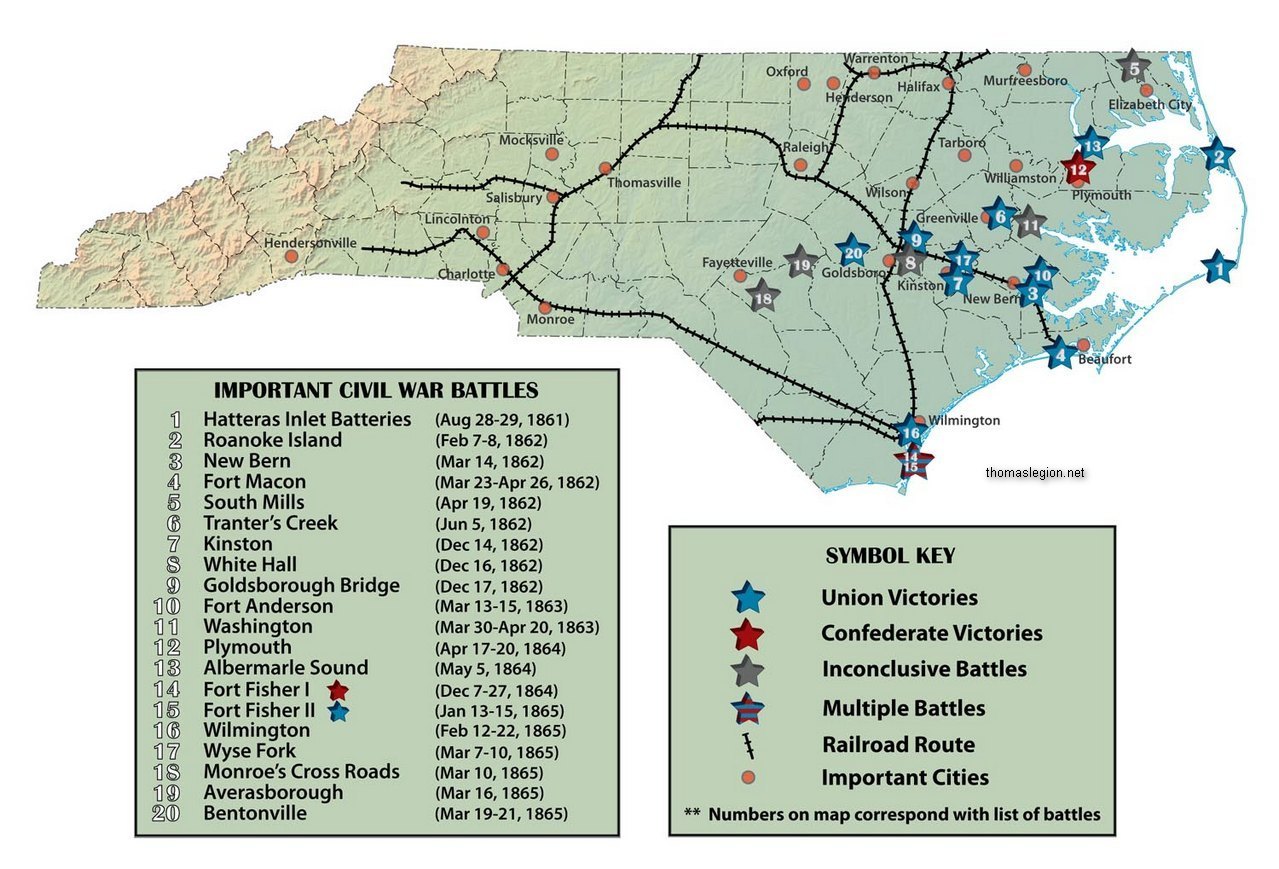
|
| Battle of Plymouth |
| Battle of Plymouth |
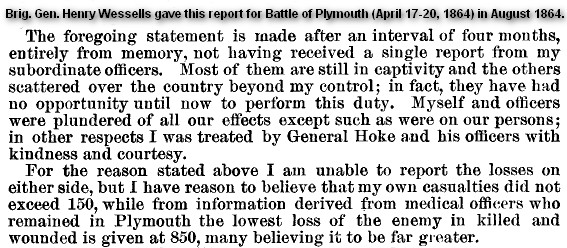
|
| Brig. Gen. Wessells and casualties during Battle of Plymouth |
Casualties
Casualty reports and figures for the Battle of Plymouth, April 17-20, 1864, have been from muddled to exaggerated, but while Federal losses were
stated more specifically, though not absolute, Confederate casualty tallies were incomplete or inaccurate. Best casualty
estimates for the respective Union and Confederate forces were derived from a variety of sources, including regimental drummers,
attending physicians, brigade commanders, and opposing commanding generals themselves. Union forces at Plymouth
suffered 2,834 casualties, including captured and an estimated 150 in dead or seriously wounded. Confederate losses, for the three
day fight, were believed to be some 850 in killed or wounded. Ransom's Brigade
alone suffered at least 476 in killed or wounded, while casualties in the other two brigades, Kemper's, under Col. William
R. Terry, and Hoke's, under Col. John T. Mercer, remain unknown. The latter two brigades, notwithstanding, having been involved
in a fierce contest on the Union right, undoubtedly suffered heavy losses. During repeated assaults on the 85th Redoubt and
nearby earthworks, and outlying forts and breastworks, both sides reported heavy losses
in the brigades under Terry and Mercy, who himself was mortally wounded on April
18 while charging the enemy's works.
(Right) Dated 18 Aug. 1864, Battle of Plymouth report filed by Brig. Gen.
Henry Wessells upon release from a Confederate prison. Official Records of the Union and Confederate Armies.
Casualty
reports or returns from Confederate commanders were incomplete for
Plymouth, so while accurate figures remain elusive, a variety of contemporary writings allow us a general idea of
the losses for those three days in April 1864. Preliminary reports, known as
after battle reports, were often revised just days or even months later. An example of a revision was moving soldiers
from wounded to mortally wounded, or from missing to killed. On the other hand,
reminiscences and diaries for this fight oftentimes stated from
outright embellishments to perhaps unintentional exaggerations. Casualty figures were
also speculation or hearsay, such as one referenced by Union Maj. Gen.
John L. Peck, Headquarters, Army and District of North Carolina, New Berne, N.C., April 24, 1864, when he reported that refugees
picked up by the US gunboat Whitehead said that General Wessells had lost about 400, while the enemy suffered not less than
1,500 killed and wounded.
The
day following Union capitulation, April 21, Col. J. Taylor Wood, Aid-de-Camp, reported to Confederate President Davis, "our
loss about 300 in all." While the Aid-de-Camp had estimated 300 casualties for Hoke's command, the regimental
and battalion returns had not yet been completed. But a few weeks later, the Fayetteville Observer, May 9, shows
identical casualty figures for Ransom's Brigade (476 casualties, or 62 killed and 414 wounded) from both John W. Faison, Adjutant,
and Captain S. H. Gee, Assistant Adjutant and Inspector General. But in 1901, Ransom's Brigade, Histories of the
Several Regiments and Battalions from North Carolina in the Great War 1861-'65, Volume 4, the writer said that "The
loss in Ransom's Brigade was over one hundred killed, and five hundred wounded. The brigade captured three thousand prisoners,
one hundred pieces of artillery, five hundred horses, a large number of small arms and a large quantity of quartermaster and
commissary stores."
As a Confederate POW, Wessells would file his reports during the summer
of 1864, and just months after the fight. While he gave specifics for Union casualties, he also gave estimates for total
Confederate losses. Whereas Wessells gave casualty figures for each unit under his command, Confederate commanders would also
state the exact tally given by Wessells for their official reports. Much later, around 1900, when North Carolina made its
grand effort to write and preserve the histories of the several regiments and battalions from the Old North State in the Civil
War, many of those who wrote the histories gave estimates, while some gave round numbers,
or the best figures available to them at that time.
A few weeks following the engagement,
Captain S. H. Gee, Assistant Adjutant and Inspector General, gave specific figures on losses for Ransom's Brigade, which was
one of the three participating Confederate brigades at Plymouth. In 1900, or 35 plus years later, many writing their
unit histories gave rounded figures, such as, Ransom's Brigade suffered 100 killed and 500 wounded. These figures were often
accompanied by other rounded tallies, such as 3,000 Union prisoners and the capture of 100 artillery pieces. In 1901, for
its official sketch, Histories of the Several Regiments and Battalions from North Carolina in the Great War 1861-'65,
Volume 1, the writer affirmed 154 casualties for the 8th N.C. Regiment alone, a higher figure, or 21% increase, than
the 127 reported by the brigade itself following the battle. "Plymouth was a brilliant victory, but the Eighth Regiment paid
dearly for its share in it. The regiment lost one hundred and fifty-four men killed and wounded, about one-third of its number."
H. T. J. Ludwig, Drummer, Company H, Eighth Regiment North Carolina State Troops.
For a year and a half, the Union military had erected an extensive ring of defenses in
and around Plymouth. The Confederates made, at intervals for three days, continued infantry assaults headlong into a
well-dug in and fortified adversary, which would easily attribute and explain the 850 plus casualties, in killed or wounded,
that Brig. Gen. Wessells asserted in August 1864. And with Confederate reports of nearly 500 casualties in the lone brigade
commanded by Ransom, then to extrapolate another 350 or so casualties split between the other two active brigades, in
addition to the numerous unattached battalions in the fray, is by no means a stretch at Plymouth.
See also
|

|

|

